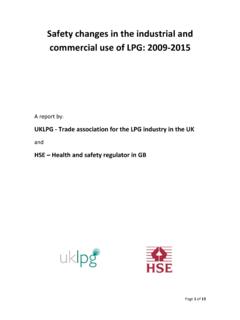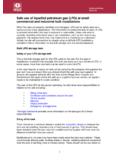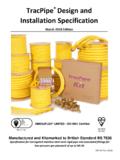Transcription of HEATBASE Ltd FACTSHEET 40 Fire separation distances for ...
1 HEATBASE Ltd FACTSHEET 40 fire separation distances for Oil storage Tanks Version 1 July 2015 Oil and LPG Fuel storage installations including the pipework connecting them to the combustion appliances in the buildings they serve should be located and constructed so that they are reasonably protected from fires which may occur in buildings or beyond boundaries. fire risk structures are not always defined as a building and can include garages, garden sheds, greenhouses, out buildings, mobile homes, static caravans, childrens playhouses, and movable or fixed position barbeques etc. Domestic Oil Tank Installation of 3500 Litres or less The Oil tank should be positioned at least away from a flue terminal, a window or door or the wall of a building that does not incorporate a method of fire protection rated to 30 minutes. If a tank cannot be positioned as above, a radiation barrier (with a 30 minute fire resistance) extending at least 300mm above and to each side of the tank could be used.
2 The Oil tank should be positioned at least 760mm from a boundary line that does not incorporate a method of fire protection rated to 30 minutes or 760mm from any part of the boundary that could be combustible hedges and foliage. If a tank cannot be positioned as above, a radiation barrier (with a 30 minute fire resistance) extending at least 300mm above and to each side of the tank could be used. The Oil tank can be located closer than from the eaves of a building that are not fire rated providing there is no combustion appliance within the roof space and the building has an internal ceiling with a fire resistance of at least 30 minutes; otherwise the eaves of the building will also require a radiation barrier to the requirements above. The Installation should incorporate a Non-combustible base extending a minimum of 300mm each side of the Oil tank. An exception to the requirement of a 300mm non-combustible base would be when an Oil tank is installed closer than 300mm from a non-combustible wall or radiation barrier with a fire resistance of 30 minutes, which extends 300mm higher and wider to each side of the tank.
3 In this case, the Oil tank should be kept at least 100mm away from the wall to allow that side of the Oil tank to be inspected. The other sides of the base should still extend a minimum of 300mm. Non-Domestic Oil Tank Installation of 3500 Litres or less The Oil tank should be positioned at least 2m away from a flue terminal, a window or door or the wall of a building that does not incorporate a method of fire protection rated to 60 minutes. If a tank cannot be positioned as above, a radiation barrier (with a 60 minute fire resistance) extending at least 900mm above and to each side of the tank could be used. The Oil tank should be positioned at least 2m from a boundary line that does not incorporate a method of fire protection rated to 60 minutes or 2m from any part of the boundary that could be combustible hedges and foliage. If a tank cannot be positioned as above, a radiation barrier (with a 60 minute fire resistance) extending at least 900mm above and to each side of the tank could be used.
4 The Oil tank can be located closer than 2m from the eaves of a building that are not fire rated providing there is no combustion appliance within the roof space and the building has an internal ceiling with a fire resistance of at least 60 minutes; otherwise the eaves of the building will also require a radiation barrier to the requirements above. The Installation should incorporate a Non-combustible base extending a minimum of 300mm each side of the Oil tank. An exception to the requirement of a 300mm non-combustible base would be when an Oil tank is installed closer than 300mm from a non-combustible wall or radiation barrier with a fire resistance of 60 minutes, which extends 900mm higher and wider to each side of the tank. In this case, the Oil tank should be kept at least 100mm away from the wall to allow that side of the Oil tank to be inspected. The other sides of the base should still extend a minimum of 300mm.
5 Domestic and Non-Domestic Oil Tank Installations of 3501 Litres and above The Oil tank should be positioned at least 6m away from a flue terminal, a window or door or the wall of a building that does not incorporate a method of fire protection rated to 120 minutes. If a tank cannot be positioned as above, a radiation barrier (with a 120 minute fire resistance) extending at least 900mm above and to each side of the tank could be used. The Oil tank should be positioned at least 6m from a boundary line that does not incorporate a method of fire protection rated to 120 minutes or 6m from any part of the boundary that could be combustible hedges and foliage. If a tank cannot be positioned as above, a radiation barrier (with a 120 minute fire resistance) extending at least 900mm above and to each side of the tank could be used. The Installation should incorporate a Non-combustible base extending a minimum of 300mm each side of the Oil tank.
6 An exception to the requirement of a 300mm non-combustible base would be when an Oil tank is installed closer than 300mm from a non-combustible wall or radiation barrier with a fire resistance of 120 minutes, which extends 900mm higher and wider to each side of the tank. In this case, the Oil tank should be kept at least 100mm away from the wall to allow that side of the Oil tank to be inspected. The other sides of the base should still extend a minimum of 300mm. Above ground Oil tank located inside a building If a Domestic Oil tank under 3500 Litres is located inside a building it must be in a compartment or chamber with a 60 minute fire resistance, be either integrally bunded or incorporate a masonry catch pit. It must have a 60 minute fire resistant self-closing door which opens outwards and is readily openable from inside the chamber without the need of a key. The chamber should be ventilated (preferably by natural means) to the open air to prevent stagnation and there must be sufficient access around the tank for inspection and maintenance.
7 Any electrical lighting provided within the chamber should be of the bulkhead or well glass type and the switches should be outside the chamber. If a Domestic Oil tank of 3501 Litres or more, or a Non-domestic Oil tank of any size is installed within a building, independent advice from the Local Authority and fire Brigade should be sought due to the complexity of Commercial fire Regulations. separation distances BETWEEN LPG CYLINDERS AND TANKS AND DOMESTIC OIL TANKS Just like the regulations relating to Oil storage with regards to protection against fire , there are fire separation distance relating to LPG storage distances from Oil tanks and flue terminals; strangely the oil regulations only refer back to the LPG regulations for information! So: UKlpg User Information Sheet 010 Formerly LPGA Technical Memorandum November 2004 Cylinders Both Code of Practice 24 part 1 and British Standard 5482 part 1 specify a distance from LPG cylinders and readily ignitable materials which should not be less than 1m.
8 Readily ignitable in terms of oil tanks means those containing products having a flash point of 65 C or less. This includes most domestic heating oils. In view of the difficulty of establishing the flash point at domestic premises, the possible change to a fuel having a lower flash point, the risk of obstruction of the oil filling process and the risk of oil spillage over cylinders the separation distance of 1m should be maintained even if the flash point is understood to be above 65 C. Bulk LPG Vessels The separation distance between bulk LPG tanks and oil tanks / tank bunds is given in Code of Practice 1 part 1, Table 2. For oil tanks containing up to 3000 litres of product having a flash point of 65 C or less and LPG tanks up to 60 tonnes this distance is 3m. To allow access and ventilation to the LPG tank the separation distance between bulk LPG tanks and oil tanks containing products having a flash point of more than 65 C should not be less 1m.
9 Therefore, Bulk LPG storage tanks should be sited at least 3 meters from an Oil storage tank with a volume of up to 3000 Litres (if the Oil tank is above this capacity independent advice should be sought from the Local Authority and fire Brigade). LPG bottles/cylinders should be kept a minimum of 1 meter from Oil storage tanks. Any flue terminal should be a minimum of 300mm above the bottles/cylinder and 1 meter horizontally. This regulation is from the LPG side of the Industry and is giving distances from an LPG boiler flue and is very confusing as there is no mention of distances from an Oil boiler flue (which is from an oil tank) and no one seems to be able to clarify what distance an oil boiler flue should be from an LPG cylinder!






